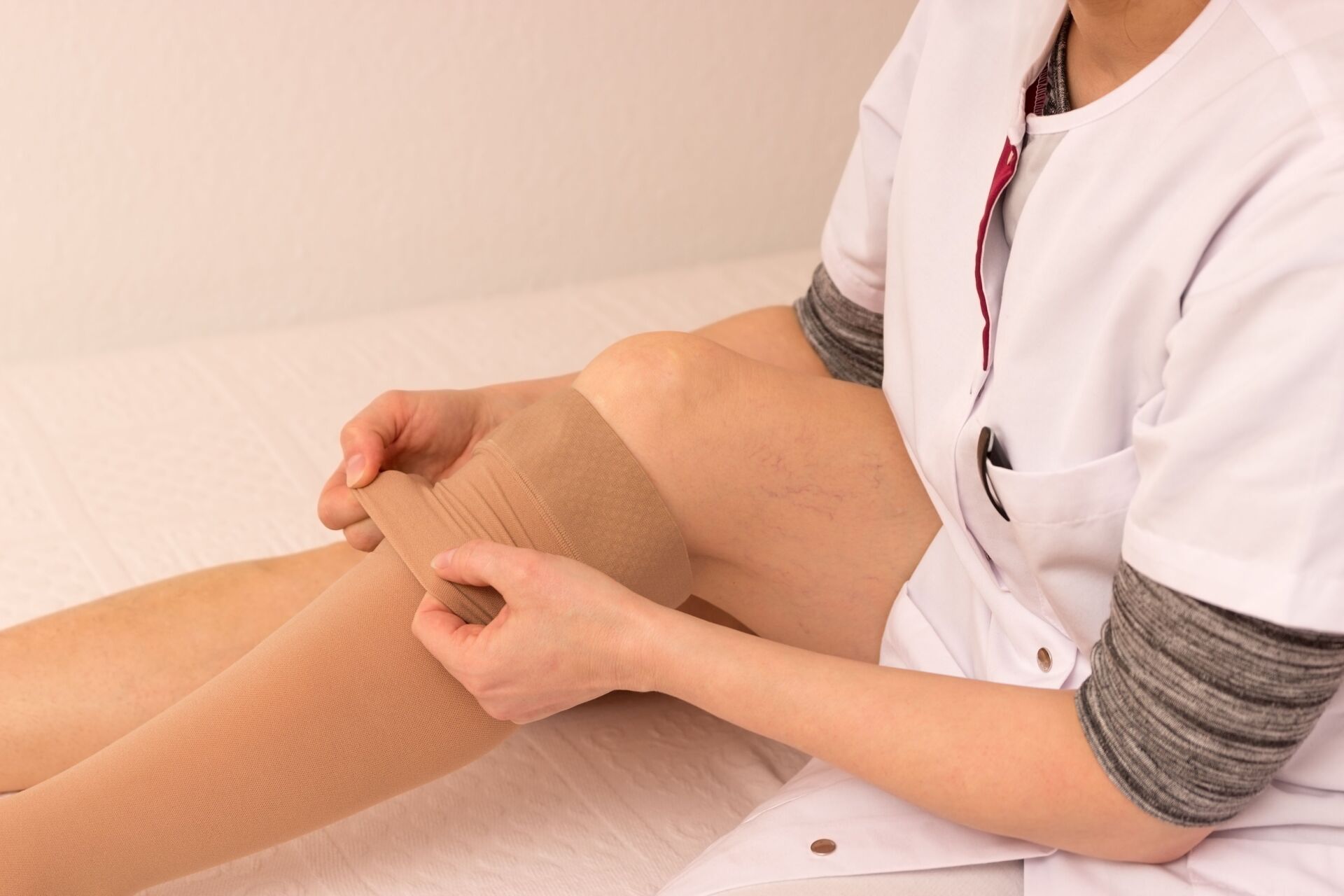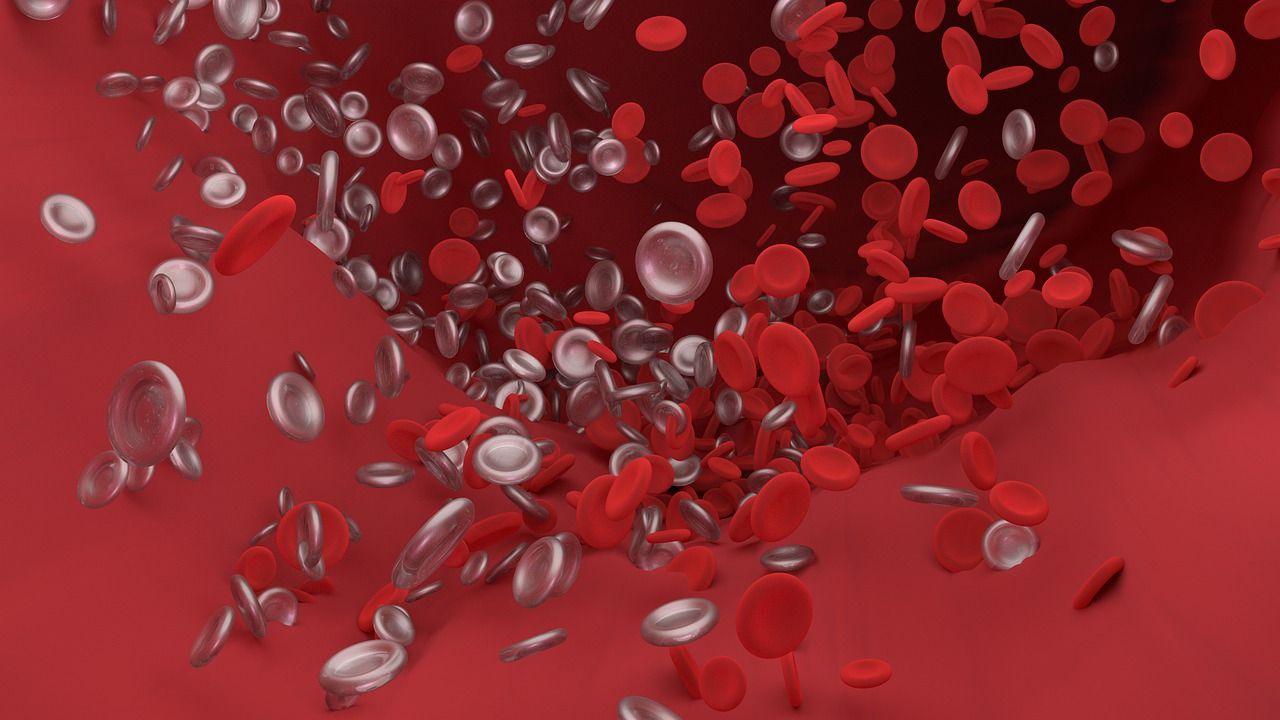In a thrombosis, a blood clot forms in a blood vessel or directly in the heart. This blood clot obstructs the blood flow. Every thrombosis is an emergency. Important symptoms of a blood clot are swelling, pain and a red or bluish discoloration of the skin. We give you an overview of triggers, risk factors, types of thrombosis and treatment options.
Thrombosis
Blood clot
Thromboses are common condition. In Europe, up to 500,000 people die from thrombosis every year. In most cases, this is a venous thromboembolism.

Pflegekraft hilft Antithrombosestrümpfe anzuziehen
Overview: What is thrombosis?
In a thrombosis, a blood vessel is blocked by a blood clot, the so-called thrombus. In Greek, the word “thrombus” means something like “clot” or “lump”. Thromboses are ticking time bombs. If a blood clot detaches from the vessel wall, there is a risk of life-threatening consequences such as pulmonary embolism or stroke. In principle, a thrombosis can form in all vessels and regions of the body. If you suspect that you have developed a thrombosis, you must act quickly and have the symptoms checked out by a doctor. This is because it is crucial to start treatment quickly in the event of a thrombosis.
Thrombosis: Causes and risk factors
There are various causes of blood clots (thromboses). These are usually characterized by three factors, also known as the Virchow triad. These are:
- Changes to the vessel wall (vessel wall/endothelial damage)
- Changes in the flow rate (hypocirculation, stasis) of the blood
- the number of cells in the blood and/or coagulability of the blood (disturbance of hemodynamics, rheology, hemostasis)
Other causes of thrombosis can be:
- Flow obstructions in the blood vessel due to damage to the vessel wall
- Narrowing of the blood vessels due to scarring or tumors
- Slowed blood flow due to varicose veins or lack of fluids
- an increased tendency of the blood to clot, for example due to a systemic illness, medication or smoking
Risk factors that favor the development of a blood clot:
- Pregnancy, childbirth
- pronounced varicose veins (varicosis)
- Vascular wall constriction due to arteriosclerosis and factors that promote this (smoking, high blood pressure)
- Medication such as the contraceptive pill, hormone preparations for treatment during the menopause or cancer medication
- Lack of exercise (prolonged sitting)
- Vascular inflammation
- Severe overweight (obesity)
- Prolonged bedriddenness (immobilization)
- Preceding thrombosis or pulmonary embolism
- Inherited or acquired blood clotting disorder (e.g. factor V Leiden mutation)
- Increased blood clotting tendency (for example after major surgery such as a hip replacement or knee replacement)
- Injuries
- serious infectious diseases
- Blood disorders in which the blood becomes more viscous (e.g. polycythemia, i.e. excessive proliferation of red blood cells)
- Age (from 50 years, for women from 40 years)
- Fluid deficiency
- Circulatory shock
- Heart failure (cardiac insufficiency)
- Cancer diseases
What types of thrombosis are there?
The risk of thrombosis increases with age. Between the ages of 20 and 40, only one in 10,000 people develop a thrombosis each year. Among the over 75s, it is already one in 100.
Types of thrombosis
A thrombosis can generally develop in all vessels of the body.
| Type of thrombosis | Where does it occur? | Possible causes |
|---|---|---|
| arterial thrombosis (arteriothrombosis) |
|
|
| Venous thrombosis (Phlebothrombosis) |
|
|
Arterial thrombosis
Arterial thromboses are mainly caused by damage to the vessel walls. This damage is usually the result of hardening of the arteries (arteriosclerosis). In this vascular disease, connective tissue, blood lipids and calcium are deposited on the vessel walls. These deposits are technically known as plaques. If the plaques break open, a blood clot can form and block the vessel. If this happens in the carotid artery, there is a risk of a stroke. Arterial thromboses can also occur in the coronary arteries. This can lead to a heart attack.
Superficial and deep vein thrombosis
Superficial vein thrombosis is usually the result of varicose veins. Infections and injuries are also possible causes. Thrombophlebitis usually occurs in the legs, more rarely in the arm. Superficial venous thrombosis is not life-threatening. Unless it develops into a deep vein thrombosis. Deep vein thrombosis is usually caused by a slowed blood flow and an increased tendency to clot. The large veins that lie deeper in the body or the extremities and lead to the heart become blocked. If the blood clot detaches from the vessel wall, there is a risk of pulmonary embolism. In around 60 percent of cases, deep vein thrombosis occurs in the legs, in around 30 percent in the pelvis. Thrombosis in the arm is very rare.
Venous thromboses are divided into the following subcategories:
Deep vein thrombosis of the leg and pelvic vein thrombosis (DVT)
Deep vein thrombosis is one of the most common forms of thrombosis, accounting for 60 percent, followed by pelvic vein thrombosis with 30 percent. DVTs usually occur in a large vein in the thigh, lower leg or calf muscles. These large veins carry deoxygenated blood directly to the heart. More rarely, a thrombosis forms in a superficial leg vein. This is usually triggered by a blood sample or an infusion.
Traveler’s thrombosis: Relatively rare
The risk of traveler’s thrombosis on a long-haul flight is lower than is often assumed. In fact, around two in 10,000 people suffer from traveler’s thrombosis in the vein. This corresponds to 0.02 percent. There is an increased risk of developing travel-associated thrombosis after a flight duration of four hours. Patients who have already suffered from venous thromboembolism in the past and are no longer taking anticoagulant therapy should consider taking prophylactic medication for longer flights.
Sinus vein thrombosis
A sinus vein thrombosis is a blood clot in the veins of the brain. As a result, blood builds up in the brain. Without treatment, a stroke occurs. Sinus vein thrombosis is much rarer than occlusion of an artery in the brain.
Thrombosis of abdominal vessels
Thrombosis in the abdomen is caused by a blood clot in the portal vein, hepatic veins, vena cava, mesenteric veins or splenic veins.
Symptoms: Thromboses cause various symptoms
Thromboses cause very different symptoms depending on where they occur. Especially in the initial phase, thrombosis symptoms are often very atypical. Arterial thromboses cause immediate pain that does not go away even at rest. Some venous thromboses, on the other hand, can be almost painless.

Typical symptoms of thrombosis
- pulling or cramp-like pain (similar to sore muscles)
- Pressure on the affected area increases the pain
- Skin changes: blue-reddish shiny skin, protruding veins
- Swelling
Symptoms of thrombosis in the arm
A thrombosis in the arm is usually very painful. The arm swells and the veins become more visible on the surface of the skin.
Symptoms of thrombosis in the leg
The possible symptoms of venous thrombosis include
- Overheating of the leg
- Spontaneous and/or load-dependent pain that improves when the affected leg is elevated
- Pressure pain on the inside of the sole of the foot (so-called Payr’s sign); later also directly on the affected vein
- Feeling of tension when the affected leg is lowered, sufferers experience a kind of muscle soreness or pulling pain
- Calf pain on pressure (so-called Meyer’s sign)
- Calf pain when flexing the foot (so-called Homans’ sign)
- Increasing swelling with increasing leg circumference
- superficial veins become more prominent (so-called warning veins)
If a pulmonary embolism develops as a result of the thrombosis, the following symptoms may also occur, depending on the severity:
- Mild or pronounced shortness of breath
- Dizziness
- Great fear and anxiety
There is a danger to life in the event of respiratory arrest. If you notice these signs, you should call the emergency services immediately.
Thrombosis: Diagnosis with us
If thrombosis is suspected, we confirm the diagnosis with imaging procedures, e.g. sonography, magnetic resonance imaging or computer tomography. The success of the therapy depends crucially on how long the blood clot has been present. This is why a quick diagnosis is important.
Ultrasound examination provides information
Special ultrasound examinations such as compression sonography or Doppler sonography are suitable for detecting or ruling out thrombosis. Both examinations are now considered standard procedures for detecting thrombosis.
Blood test
A blood test can also provide indications of a thrombus. This is because thromboses leave traces in the blood, the so-called D-dimers.
Thrombosis: Prevention, early detection, prognosis
There are various measures to prevent thrombosis.
Tips for thrombosis prophylaxis
The following tips will help you to reduce the risk of thrombosis. These are above all general measures for better health:
- Get plenty of exercise, preferably every day. Endurance sports such as cycling, swimming or walking are particularly suitable. Alternatively, you can go for a brisk walk for half an hour a day.
- Stop smoking.
- Reduce your weight if necessary.
- Drink only a little alcohol.
- Avoid sitting and standing for too long.
- Rinse your body with cold water after showering.
- Eat a balanced diet.
- Drink 1.5 to 2 liters a day. Tap water, mineral water, juice spritzers or unsweetened fruit or herbal teas are best.
- Wear compression stockings after operations or childbirth.
Further measures can be considered after a thrombosis. In consultation with your doctor, you can prevent new thromboses by taking anticoagulant medication. Known thrombosis medications are:
- Apixaban,
- Rivaroxaban,
- Dabigatran,
- Edoxaban
- Argatroban,
- Heparins or heparinoids,
- Danaparoid,
- Fondaparinux,
- Vitamin K antagonists: phenprocoumon (Marcoumar®) or warfarin (Coumadin®).
The active ingredient acetylsalicylic acid (ASA) is only used to prevent arterial thrombosis and shows only minimal effects in venous thromboembolism.
Course
Various complications can occur during the course of a thrombosis:
- Pulmonary embolism: An embolism occurs when the blood clot or part of it becomes detached and is carried away with the blood. The clot can travel via the veins and the right heart into the lungs and cause a pulmonary embolism.
- Blood poisoning: Another serious complication is colonization of the blood clot with bacteria. If these spread through the blood, blood poisoning occurs. Treatment with antibiotics can help here.
- Post-thrombotic syndrome: If a thrombosis is treated too late, permanent damage to the venous valves can lead to venous insufficiency (chronic venous insufficiency). If the blood flow – especially from the legs – is permanently impeded, ulcers (leg ulcers) can form. An open leg usually heals badly.
Prognosis
In the case of thrombosis, the prognosis depends heavily on the patient’s medical history and the clinical circumstances of the thromboembolism. People who have already had a thrombosis have an increased risk of another thrombosis. If you have risk factors, you should consistently start taking measures to prevent thrombosis
Thrombosis: Treatment to dissolve blood clots
Venous and arterial thromboses are treated differently. In both cases, it is first important to dissolve the blood clot and restore blood flow. The treatment is also intended to prevent the blood clot from growing further or forming new blood clots.
These three treatment options are available:
- Anticoagulant therapy: Anticoagulant medication such as heparin, heparinoids or oral anticoagulants support the body in its efforts to break up the blood clot and, in the best case, dissolve the thrombosis again. Thrombosis medication is given as an infusion or injection. Blood-thinning medication can be administered as an injection or infusion or swallowed.
- Pressure: The use of compression stockings is an auxiliary measure for thrombosis. These exert pressure on the veins so that the blood can flow faster.
- Surgery: Thrombosis surgery is another option for treating thrombosis. During the operation, the thrombus is captured directly in the bloodstream and removed.
